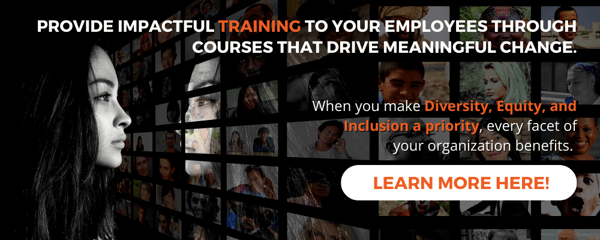For the first time in history, there are five generations in the workplace: The Silent Generation, Baby Boomers, Gen X, Millennials, and Gen Z. Different generations each bring to the workplace different perspectives, values, and work styles, which can sometimes lead to misunderstandings and conflict. However, this unique scenario can also have positive impacts if organizations can harness the diversity of the different generations.
To maximize productivity and ensure a positive working environment, it is important for employers to understand each generation's unique strengths and weaknesses.
"We can't expect the world to get better by itself. We have to create something we can leave the next generation." - Gwen Ifill
Understand the Different Experiences Each Generation Brings to the Workplace
Of course, every individual is unique, so generalities do not always apply. However, every person within each generation has experienced the world in a similar way, but in a way that is sometimes vastly different from other generations. As a result, there tend to be more commonalities than not among people in a generational category.
For example, Baby Boomers' life experiences may lead to them being more comfortable with face-to-face communication, while Millennials may tend to emphasize technology to a larger degree.
Businesses that appreciate these differences can foster team collaboration, increase morale and productivity, decrease generational conflict, and create an environment that appeals to employees of all ages. If businesses are open to adapting their workplace culture, they can better understand the different experiences each generation brings and reap the rewards associated with this enhanced understanding.
the 5 generations:
-
the silent generation (aka traditionalists) (born 1927-1946)- traditionalists are the oldest generation in the workplace and are known for their loyalty, work ethic, respect for authority, and commitment to excellence. They have a strong sense of responsibility and prefer following rules and procedures. Traditionalists often take great pride in their work but may struggle with adapting to new technologies or changes to processes.
-
Baby Boomers (born 1946-1964)- Baby Boomers are known for their strong work ethic, loyalty to the company, and dedication. They value face-to-face communication and respect authority. While they may be more comfortable with traditional leadership styles, Boomers can benefit from training that encourages collaboration and innovation.
-
Generation X (born 1965-1980)- gen x individuals are often independent, self-reliant, and highly adaptable. They are comfortable with technology and prefer autonomy to collaboration. Generation Xers also bring highly sought-after skills, such as problem-solving, critical thinking, multi-tasking, and creativity to the workplace.
-
millennials or generation y (born 1981-1996)- Millennials have grown up with technology at their fingertips and are often more tech-savvy than their older colleagues. Millennials value team collaboration, prefer feedback to criticism, and thrive in an environment of constant change. They also bring fresh ideas and enthusiasm to the workplace.
-
generation z (born 1997-Prrsent)- people in the gen z category value honesty, integrity, and creativity. They are highly connected through social media and prefer to communicate through technology. Generation Z is also comfortable with multitasking and adept at using multiple platforms for collaboration.
To ensure a successful work environment, employers should create an environment that embraces the strengths of each generation and provides opportunities for intergenerational understanding. By recognizing the unique qualities of each generation and leveraging their collective strengths, employers can create a productive and successful work environment.

Bridging the Gap Between Generations by Embracing Diversity
Diversity is one of the greatest strengths that an organization can tap into. By sparking conversations and increasing understanding between people of different ages, backgrounds, religions, genders, and more, bridges can be built between generations, resulting in better collaboration and stronger communities.
Embracing diversity means being open to learning new approaches to problem-solving regardless of age, nationality, or other factors. It gives us the opportunity to truly benefit from the perspectives of others. It also transforms our workplaces into culturally diverse environments that foster acceptance of different points of view, creating an inclusive atmosphere across generations. When we all feel accepted and respected for who we are and where we come from, gaps can start to be closed and collaboration across generations becomes possible.
One way that companies can embrace diversity is through employee resource groups. ERGs can foster a sense of understanding within a workforce by bringing together individuals who share commonalities unrelated to age. For instance, an employee resource group built around gender or race might include participants from any (or all) of the five generations.
Adapting Workplace Practices to Accommodate Multi-Generational Teams
Working with multi-generational teams can be a difficult balancing act for many bosses. Still, it also presents a major opportunity to gain different perspectives and draw on diverse experiences and backgrounds.
The Readiness Gap: 70% of organizations say leading multigenerational workforces is important or very important for their success over the next 12-18 months, but only 10% say they are ready to address this trend.
Employers should look for ways to harness the strengths of each generation. Inviting input from everyone involved in a project, paying attention to generational values, adjusting expectations of communication and collaboration styles, and providing mentoring programs that encourage cross-generational learning are all great strategies for creating workplaces that acknowledge the needs of various age groups.
Creating an Inclusive Culture to Foster Intergenerational Collaboration
Creating an inclusive culture to foster intergenerational collaboration is essential in today's workplace. In diverse workplaces, employees of different generations can bring valuable perspectives and experiences to the table. An interconnected environment enables workers of all ages to come together, exchange ideas and collaborate to achieve business objectives.
A positive, accepting environment for communication promotes mutual respect and understanding among all generations, encourages group problem-solving, and produces more innovative solutions. Involving people from a range of backgrounds in team-building activities can help build trust and break down generational barriers.
5 tips on building a multi-generational workforce:
-
develop a flexible culture. Employees of different generations may prefer to work in different ways. Companies seeking to maximize the benefits of a multi-generational workforce should be "willing to adapt and adjust based on the needs of your people and the demands of your business."
-
implement mentorship programs. each generation can learn from the others, and well-structured mentorship programs can be a great way for employees to develop a "mutually respectful bond with a peer from a different generation."
-
embrace individual perspectives. recognize employees for what they contribute, not what generation they are from. When employees see that recognition and rewards are tied to contributions, they adopt a similar attitude. Employees have different ways of thinking and behaving, Let your team know that you value their individual experiences. By using assessment tools, you can help gain clarity around the perspectives of your team members and help tailor the communication style to match that of each teammate. By sharing how each of your team members think, you can help them better understand each other’s preferences and appreciate the unique perspectives they bring to the table, no matter their age.
-
create an environment of open communication. you can't have strong collaboration without effective communication. To positively channel generational diversity in the workplace, it is best to create an environment where each member of your team has a forum to be heard and feels confident that their input will be respected, even if the team chooses an alternative direction.
As a leader, you can foster open communication by being transparent and encouraging your employees to provide their insights, ideas and feedback. Make sure that you set the example by listening without interruption while your employees share their perspectives. Ask clarifying questions to understand their point of views.
-
avoid making assumptions. while it is true that individuals from a generation often share common experiences and traits, it is important to avoid making assumptions based on age. Instead, managers should learn to ask employees how they would handle an opportunity and listen fully to the answer without bias.
As the workforce transitions into an era with multi-generational employees, businesses must remain conscious of the needs and experiences of each generation. Leadership must actively bridge the gap between generations by embracing diversity and adapting workplace practices that bring out the best from members of all ages.
Multi-Generational Success in the Workplace
Intergenerational collaboration is an important part of a successful workplace and has the potential to bring together different perspectives and experiences. There are many ways for companies to foster this kind of collaboration, such as investing in training related to intergenerational communication, promoting mentorship opportunities, creating teams with employees from multiple generations, and incorporating technology designed for multigenerational workforces.
Employee assistance programs can also help facilitate intergenerational collaboration by providing resources to help employees with their unique needs and challenges related to working across generations. Employee assistance programs can provide support in areas such as career development, stress management, personal growth, and improving communication skills among team members. By taking advantage of employee assistance programs, companies can create an environment that fosters collaboration between all generations in the workplace.
When you partner with Ulliance, our Life Advisor Consultants are always just a phone call away to teach ways to enhance your work/life balance and increase your happiness. The Ulliance Life Advisor Employee Assistance Program can help employees and employers come closer to a state of total well-being.
Investing in the right EAP or Wellness Program to support your employees will help them and help you. Visit https://ulliance.com/ or call 866-648-8326.
The Ulliance Employee Assistance Program can address the
following issues:
• Stress about work or job performance
• Crisis in the workplace
• Conflict resolution at work or in one’s personal life
• Marital or relationship problems
• Child or elder care concerns
• Financial worries
• Mental health problems
• Alcohol/substance abuse
• Grief
• Interpersonal conflicts
• AND MORE!
Have some question about our services? Book a quick meeting below!
References:
4 Secrets to Build a Happy Intergenerational Workforce, Tien Viet Nguyen https://blog.grovehr.com/intergenerational-workforce
13 Tips for Bringing Your Multi-Generational Workforce Together, Expert Panel - Forbes Coaches Council, https://www.forbes.com/sites/forbescoachescouncil/2019/02/12/13-tips-for-bringing-your-multi-generational-workforce-together/?sh=5f343b541c6d
Can 5 Generations Coexist in the Workplace? Jack Kelly, Forbes, https://www.forbes.com/sites/jackkelly/2023/03/01/can-five-generations-coexist-in-the-workplace/?sh=1a7d82bf31f2
Generations in the Workplace, David Rise, HR Exchange; https://www.hrexchangenetwork.com/employee-engagement/articles/generations-in-the-workplace
The Post generational Workforce: From Millennials to Perennials, Deloitte, https://www2.deloitte.com/us/en/insights/focus/human-capital-trends/2020/leading-a-multi-generational-workforce.html
Emergenetics International, 5 Ways to Foster Collaboration in a Multigenerational Workforce, https://emergenetics.com/blog/five-ways-to-foster-collaboration-in-a-multigenerational-workforce/

